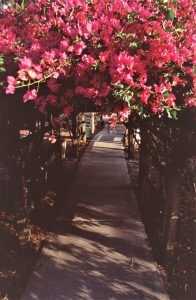
What is catching my eye in our landscapes these days? Bright and beautiful bougainvillea, of course! Bougainvillea are blooming profusely right now and will continue on through the winter for eight weeks or more. Perfect as a flowering vine, the bougainvillea is also adaptable as a hedge, in hanging baskets, an accent plant or pruned as a standard upright plant. Although a thorny plant, the bougainvillea more than makes up for this with colorful bracts (not true flowers) in shades of pink, purple, orange, and white that will provide a florescent glow that no other flowering woody plant can.
While bougainvillea are great for our area, gardeners sometimes have problems with them. One problem is lack of flowers. Bougainvillea must be grown in full sun to promote a good bloom. Too much fertilizer can also be a problem that can inhibit blooming. Also, keep your bougainvillea on the dry side to encourage, not only for plenty of blooms, but healthy roots as well. Another concern expressed by local gardeners is leaf drop in bougainvillea. This situation can be linked to over-watering, not enough sun and/or cold temperatures. While water is important for establishment, over-watering this drought- tolerant plant with a misdirected or overactive sprinkler is a mistake. Often leaf drop is simply a natural occurrence after a flowering period which is soon followed by a flush of new growth – just be patient.
Beware the thorns! I have experienced numerous bloodlettings by pruning or even just working around bougainvillea. Wearing heavy-duty, long-sleeved gloves is the solution. Normal-sized cultivars can be pruned as shrubs or trained on fences or trellises – they can even be espaliered. While bougainvillea can be trimmed lightly year-round, this woody plant is best pruned sometime between late winter/early spring after it flowers, or at the beginning of the rainy season. Natural dwarf types need next to no pruning and can be used as groundcovers, in hanging baskets or cascading over a wall.
Bougainvillea prefer slightly acidic, well-drained soil in a full sun location. On high pH alkaline soils, you may notice chloric (yellowing) leaves due to certain micronutrients being locked-up and unavailable to the plants. While having a soil test first before planting is the best approach (plan before you plant), if you already have one in the landscape that is suffering from nutritional issues, you can use a foliar nutrient spray (one suitable for citrus or palms) as per label directions to help supply these missing nutrients. These materials can stain concrete and stonework, so be careful with application.
For use in the landscape, there are a number of cultivars that will work well. An old favorite, ‘Barbara Karst’ is known for its red bracts that are in almost constant bloom. ‘Miami Pink’ is a dark pink variety also suitable for the landscape. ‘Tropical Bouquet’ is a compact and bushy variety that starts out orange and turns pink. ‘California Gold’ has gold to yellow bracts with a nice vining habit. For hanging baskets select true miniatures such as ‘Pink Pixie’, ‘Helen Johnson’ a dwarf red that is bushy and compact, or ‘Juanita Hatten’ which has red foliage with shades of green variegation. There are also some novelty or specialty cultivars that make interesting subjects to grow. ‘Double Red’ and ‘Double Pink’ offer the special feature of double bracts. Some bougainvillea have an extra feature of not only colorful bracts, but also bright foliage. ‘Raspberry Ice’ has a red bract with variegated foliage. ‘Vicky’ comes with pink bracts and leaves with yellow centers. ‘Sweet Dream’ has gold leaves, pale lavender bracts and, as a special feature, is thornless. Check your local garden centers for availability of these cultivars.
Bougainvillea should be part of your landscape – it is an approved Florida-Friendly Landscaping™ plant. Add one or two to your garden today! For more information on all types of flowering woody plants, or to ask a question, you can also call the Master Gardener Volunteer Helpdesk on Mondays, Wednesdays, and Fridays from 1 to 4 pm at 764-4340 for gardening help and insight into their role as an Extension volunteer. Ralph E. Mitchell is the Director/Horticulture Agent for UF/IFAS Extension – Charlotte County. He can be reached at 941-764-4344 or ralph.mitchell@charlottecountyfl.gov. Connect with us on social media. Like us on Facebook @CharlotteCountyExtension and follow us on Instagram @ifascharco
Resources:
Gilman, E. F. (1999) Bougainvillea spp. The University of Florida Extension Service, IFAS.
UF/IFAS Gardening Solutions (2022) Bougainvillea. The University of Florida Extension Service, IFAS.
Schoellhorn, R. & Alvarez, E. (2002) Warm Climate Production Guidelines for Bougainvillea. The University of Florida Extension Service, IFAS.
The Florida-Friendly Landscaping™ Guide to Plant Selection & Landscape Design (2022) The University of Florida Extension Services.
Source: UF/IFAS Pest Alert
Note: All images and contents are the property of UF/IFAS.



